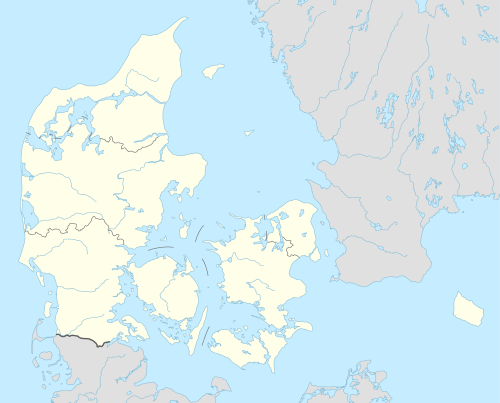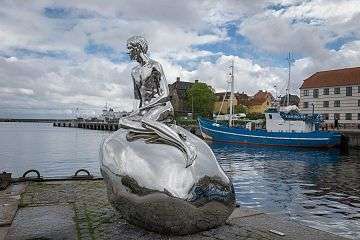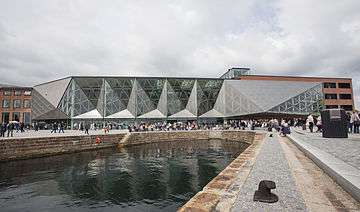Helsingør
| Helsingør Elsinore | |
|---|---|
|
Helsingør waterfront in November 2006 | |
 Helsingør Location in Denmark | |
| Coordinates: 56°02′10″N 12°36′30″E / 56.03611°N 12.60833°ECoordinates: 56°02′10″N 12°36′30″E / 56.03611°N 12.60833°E | |
| Country | Denmark |
| Region | Capital (Hovedstaden) |
| Municipality | Helsingør |
| Established | 1420s |
| City charter | 17th century |
| Current municipality | 2007-01-01 |
| Government | |
| • Mayor | Benedikte Kiær |
| Area | |
| • Total | 121.61 km2 (46.95 sq mi) |
| Elevation | 8 m (26 ft) |
| Population (2014) | |
| • Total | 61,519 |
| Time zone | CET (UTC+1) |
| • Summer (DST) | CEST (UTC+2) |
| Postal code | 3000 |
| Area code(s) | (+45) 49 |
| Website |
www |
Helsingør (Danish pronunciation: [hɛlseŋˈøɐ̯ˀ]), classically known in English as Elsinore, is a city in eastern Denmark.
Helsingør had a population of 46,492 on 1 January 2015.[1] It is known for its castle Kronborg, where William Shakespeare's play Hamlet is set. The HH Ferry route connects Helsingør with Helsingborg in Sweden.
History

The oldest known fortified building of Helsingør is Flynderborg, an early medieval fortress situated on a hill just south of the medieval city. Around 1200, the first church, Saint Olaf's Church, was built.[2] A number of convents once surrounded the church, but now all that remains is the church building, today the cathedral of the Diocese of Helsingør. The oldest parts of the cathedral of Helsingør date back to the 13th century and tell us that the fishermen's village, as Helsingør was then, had grown to a town of importance.
The name Helsingør is derived from the word hals meaning "neck" or "narrow strait", referring to the narrowest point of the Øresund (Øre Sound) between what is now Helsingør and Helsingborg, Sweden. The people were mentioned as Helsinger (which may mean "the people of the strait") for the first time in King Valdemar the Victorious's Liber Census Daniæ from 1231 (not to be confused with the Helsings of Hälsingland in Sweden).[3] Placenames show that the Helsinger may have had their main fort at Helsingborg and a fortified landing place at Helsingør, to control the ferry route across the strait.
Helsingør as it is known today was founded in the 1420s by the Danish king Eric of Pomerania. He established the Sound Dues in 1429, meaning all foreign ships passing through the strait had to pay a toll, which constituted up to two-thirds of Denmark's state income. With this income Eric of Pomerania built the castle Krogen. The castle was expanded in the 1580s and renamed Kronborg. All ships had to stop in Helsingør to get their cargo taxed and pay a toll to the Danish Crown, but it also generated a significant trade for the town. In 1672 Helsingør had grown into the third biggest town in Denmark.[4] Johan Isaksson Pontanus (Rerum Danicarum Historica, 1631) attributes a long and partially fictitious history to Helsingør.
The Sound Dues were abolished in 1857 with the Copenhagen Convention, where all naval nations agreed to pay a one-time fee.
Transport
The car ferry line between Helsingør and Helsingborg, Scania, Sweden is the busiest in the world with more than 70 departures in each direction every day.[5] The route is known as the HH Ferry route and has been sailed by several shipping lines through history. The car ferry terminal is connected to the town's main railway station. From the station, trains depart to Copenhagen every 20 minutes. Trains also depart to Hillerød and Gilleleje. There are another 6 stations or train stops within the city and connected suburbs. Apart from Helsingør Station and Ferry Terminal also Snekkersten station, Espergærde station, Mordrup station and the train stops at the line to Gilleleje, Grønnehave, Marienlyst and Højstrup [6][7] The E47 Motorway towards Copenhagen begins just outside the city limits. The town and surrounding areas also has a network of local and regional buses.[7][8]
Industrialisation
For a century, a notable site was the Helsingør Værft or Elsinore shipyard, which covered the whole area between the town and Kronborg Castle. It was founded in 1882. At its height in 1957, it had 3,600 employees. The last ship left the shipyard in 1983 and it closed the same year following heavy losses.
The Wiibroe brewery, founded in 1840, was the second brewery in Denmark to ship bottled beer, just three years after Carlsberg. The last beer was brewed at Wiibroe in Helsingør in 1998. Carlsberg continues to brew beer under the Wiibroe Årgangsøl[9] label.
Post-industrialisation

After the end of the industrial era, the town of Helsingør had to redefine itself, and came up with an ambitious project: Kulturhavn Kronborg, literally "Culture-harbour of Kronborg". It officially opened on 26 May 2013, intended to appeal to tourists with an interest in culture. The main attraction of Kulturhavn Kronborg is Kronborg Castle, a UNESCO World Heritage Site. Besides the historical attractions of the site, William Shakespeare's play Hamlet is performed annually in its courtyard since 1937. There is a longstanding tradition of performing the play in English, and notable actors in the title role have included Laurence Olivier, John Gielgud, Christopher Plummer, Derek Jacobi, and in 2009 Jude Law. At the heart of Kulturhavn Kronborg lies kulturværftet or The Culture Yard, a new cultural centre and a public library located in the old dockyard. It opened in 2010. The former dry dock now houses the Danish Maritime Museum.
In the centre of the harbour basin stands the polished steel sculpture "Han" ("He") by artist duo Elmgreen and Dragset, commissioned by the City of Helsingør in 2012. It was inaugurated by then Minister of culture, Uffe Elbæk, in June 2012. It is seen as the counterpart (and even little brother) to Edvard Eriksen's world-famous The Little Mermaid statue in Copenhagen, and has caused both praise and protests among locals.
The Swedish city of Helsingborg lies a short distance across the Øresund from Helsingør, approximately 4 km (2 mi). European route E55 joins the two cities; ferries connect the two sides.
Architecture
The new Danish Maritime Museum was designed by Danish prize-winning architects Bjarke Ingels Group (BIG).
Jørn Utzon lived in Helsingør in his youth because his father was an engineer at Helsingør Værft. Utzon designed The Kingo Houses (1956–60) and The Hammershøj Care Centre (1962) in the city. The project was completed by Birger Schmidt (1966) after Utzon moved to Sydney to work on the Sydney Opera House.
Notable natives
- Olivia Nielsen, (1852-1910), Trade union activist[10]
- Steen Rasmussen (1955–present), artificial life scientist who coined the term "complex systems dogma".
- Mikkel Hansen (1987–present), handball player who won the IHF World Player of the Year 2011.
Districts
Centrum
- North: Grønnehave (Green Gardens), Højstrup and Marienlyst, Hellebæk, Højstrup, Ålsgårde and Hornbæk
- West: Sundparken, Grøningen, Nøjsomheden and Vapnagård Gurre, Tikøb
- South: Skotterup and Snekkersten and Espergærde
International relations
Twin towns — sister cities
Helsingør is twinned with:
 Gdańsk, Poland, since 1992[11]
Gdańsk, Poland, since 1992[11] Sanremo, Italy
Sanremo, Italy Helsingborg, Sweden
Helsingborg, Sweden Harstad, Norway
Harstad, Norway Lake Elsinore, California, United States
Lake Elsinore, California, United States Pärnu, Estonia
Pärnu, Estonia
In fiction and popular culture
- William Shakespeare's play Hamlet (whence the English spelling "Elsinore" derives) takes place mostly at Kronborg Castle in Helsingør.
- In the 1983 comedy Strange Brew, which is loosely based on Hamlet, the protagonists are given jobs at Elsinore Brewery.
- In Patrick O'Brian's Aubrey–Maturin series, Helsingør fires mortar shells at the heroes in book seven, The Surgeon's Mate, as they sail past on their way to a rendezvous in the Baltic.
- In the second chapter of Philip Roth's novel Our Gang (1971), Trick E. Dixon in a fictive speech tries to claim Helsingør as US-territory and tries to convince the audience to occupy the area
- In Bret Easton Ellis's novel Lunar Park, the street on which the character Bret Easton Ellis lives, with his own haunting father-son issues, is called Helsingør Lane.
- Several stories written by the Danish author Karen Blixen (or Isak Dinesen) take place in Helsingør, including "The Supper at Elsinore" in her first published volume of stories, Seven Gothic Tales.
- A well-known poem by the Portuguese surrealist poet Mário Cesariny is named "You are welcome to Helsingør".
- Children's author Richard Scarry depicted Helsingør as "A Castle in Denmark" in the book Busy, Busy World.
- Indie-rock band The Essex Green recorded a song titled "Elsinore" for their 2006 album Cannibal Sea.
- In David Brin's novel The Postman, the first chapter features an apparition that appears to protagonist Gordon Krantz. It is described as an "Elsinorian figure" and greets Gordon with "Alas, poor Gordon!", both allusions to Hamlet.
See also
References
- ↑ "BEF44: Population 1st January, by urban areas" database from Statistics Denmark
- ↑ "Helsingør Turistbureau - Victoria Design". www.visithelsingor.dk. Retrieved 2009-10-21.
- ↑ early records of Helsingør and Flynderborg ("possibly already mentioned by Saxo"): J. D. Qvist, Annaler for nordisk oldkyndighed, Kongelige Nordiske oldskriftselskab, 1836, p. 306
- ↑ Danske byers historie gennem 1300 år
- ↑ Helsingborg ferry, compare prices, times and book tickets
- ↑ Google maps
- 1 2 http://www.moviatrafik.dk/dinrejse/kort/trafikkort/Documents/Hovedstadsomraadet/BusserHelsingor.pdf
- ↑ Kort
- ↑ Carlsberg Group - Wiibroe Årgangsøl
- ↑ Sandvad, Karin. "Olivia Nielsen (1852 - 1910)" (in Danish). Kvinfo. Retrieved 31 August 2016.
- ↑ "Gdańsk Official Website: 'Miasta partnerskie'" (in Polish and English). 2009 Urząd Miejski w Gdańsku. Retrieved 2009-07-11. External link in
|publisher=(help)
External links
| Wikimedia Commons has media related to Helsingør. |
| Wikivoyage has a travel guide for Helsingør. |
- Helsingør Tourist Bureau website (English)
- Port of Helsingør (English)
- Helsingør municipality's official website (Danish)
- Helsingør Leksikon: Local history wiki (Danish)


